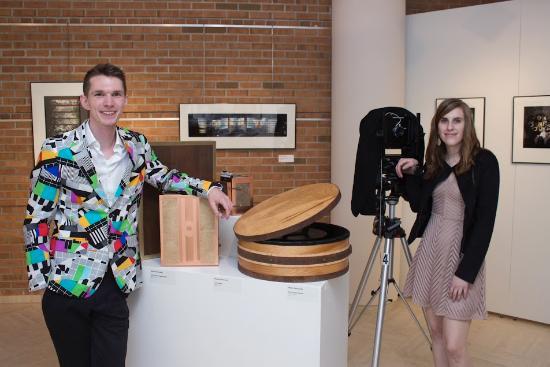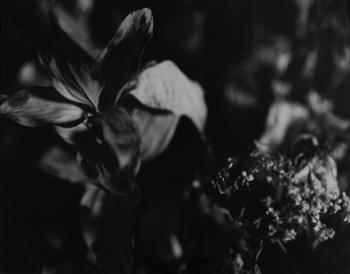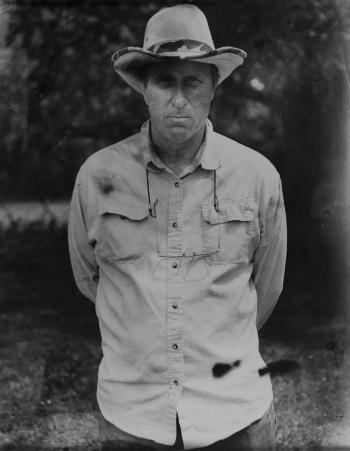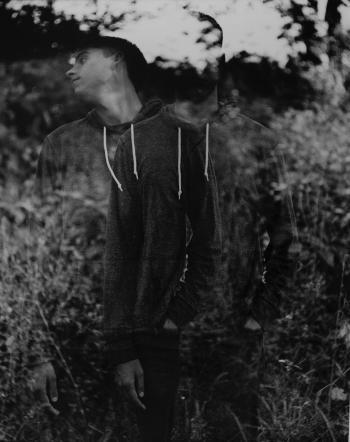Bachelor of Fine Arts Exhibition: Alison Bur & Myles Roznowski
 |
This exhibition features artworks of the graduating Bachelor of Fine Arts students Alison Bur and Myles Roznowski, and serves as a completion of their undergraduate program.

Alison Bur: Bachelor of Fine Arts Degree with a concentration in Photography
ARTISTS STATEMENT
For my series Transient, I decided to slow down and take a closer look at the people and objects in my life that matter most to me. I reexamined time and the camera’s ability to describe small intimate moments between camera, subject, and photographer. I chose the 4x5 view camera above all others because of its ability to capture more than what I can see with my own eyes. The view camera draws my attention to small details and moments I can’t see without the focus of the lens and the cropped view of the ground glass. Overall, creating a disconnect between what I see and the image that is captured, the view camera enables me to capture what I miss with the naked eye.
For me, this series is a personal journey. I began by searching for something unknown, a mystery surrounding the passage of time in my own life I was hoping the camera could help me understand. I examined time and the tension involved in holding on and letting go. Specifically looking at the tension involved in wanting to hold on to the people and objects that matter most to me but inevitably having to let go of them. I also wanted to further examine the feelings and memories attached to these people and objects and how they evolve over time. For this series, I use the camera as a way of seeing, which allows me to explore what I would normally miss and also evaluate my own perspective. Creating images that express what I am blind to but in some ways how I want to remember the subject. This allows me to step back and evaluate how time has affected my life. And within the images preserve that moment or memory which in turn helps me let go of them.
For this series, I chose the black and white silver process over digital methods in order to work at a slower, more intimate pace and really contemplate my images. I decided to print the images large to emphasize their clarity and expose their honesty, allowing them to be fully experienced. For the double exposures, I wanted to create them in real time, not exposed at different
times or with the help of digital technology. I wanted them to be raw in process by double exposing on the film in the camera at the same location. All of the double exposures are double exposed at the same location to give a feeling of fleetingness and simultaneously convey a lapse of time. Both exposures are blended seamlessly in order to draw more attention to the subject than the background. All of the backgrounds are natural landscapes to create an ambiguous and natural sense that could not be achieved by shooting in the studio.
|
|
|
 |
 |
Myles Roznowski: Bachelor of Fine Arts Degree with a concentration in Photography
ARTIST STATEMENT: “Dreamscape” & “Metamorphosis”
Some of my best work comes from curiosity. I have to experiment and explore in order to stay interested in whatever I’m working on, often making it difficult to stick with just one medium. My chosen medium is photography because it continuously surprises me with its possibilities and potential as an art form. I have become especially interested with pinhole photography because of the connection I build with the images in the process; instead of using a camera built to someone else’s specifications, I’m able to rely on my own ability to design and build pinhole cameras that are truly one-of-a-kind. Each camera’s unique characteristics introduce an element of chance into the typically very controlled medium. The series “Dreamscape” illustrates the personal relationship I have built with four of my pinhole cameras and how we’ve come to understand each other. With images such as “Shed” and “Sunroom,” they offer a raw view of the world uncorrected through an optical lens, distorting and cropping the scene into a dreamlike snip of reality. Their surreal quality is accompanied by structure and form in this series; when I take a photo, I tend to not focus on the object itself or what it represents, but rather what’s happening within the composition of the scene - looking mainly for guiding lines, interesting shapes, and color. In an attempt to re-examine the characteristics of a particular object, my photographs “Kitchen Sink” and “Red Bush” have been deconstructed through my ‘beehive’ pinhole camera; it multiplies and repeats elements of the scene through it’s 40 pinholes. The viewer is forced to look non-objectively at an objective image. The focus is more on color and repetition of pattern & texture rather than the object itself, this draws the viewer in before realizing what it actually is. The film is presented with all of its flaws and characteristics to stress its importance in the creation of the image.
I try to produce images outside the capabilities of digital photography when working with film and vice-versa with digital. My digital series, “Metamorphosis,” is inspired through the repetitious pattern of plants captured by my pinhole images. It presents their geometric qualities in a more controlled manner, focusing attention on the structural and mathematical shapes of the organic subject. Photographing them in a studio setting, the images are intended to alter the plant’s natural perception and give an ambiguous feel. Close-ups were taken of the subjects, using a black background with color floodlights to accentuate arbitrary highlights & shadows of the plant’s texture. I then mirror the image in Photoshop both vertically and horizontally. This further abstracts the form and highlights its structure, giving it a painterly quality with an overall psychedelic effect. The series invites the viewer to question the reality of the subjects and the true characteristics of an “organic” object, directly referencing their relationship to geometry, repetition, and structure.
I question my images just as much as my audience. When I’m challenged by the opportunity to experiment and create something entirely new, the artwork becomes the product of a learning process and I become driven by the excitement of the outcome. I produce a style of work that’s representational, but doesn’t necessarily rely on realistic depictions; inspired through movements such as Impressionism or Pictoralism. I like to bring a sense of fantasy and visual cohesion into my photographs, separating them from mere documentation of everyday life. I distort the photo, bring the medium to attention and use a saturated color pallet. Pinhole photographer, Pierre Charrier, has inspired much of the experimental work in this portfolio. By using up to 91 pinholes and stacking multiple rolls of film in a single image, he embraces the medium and develops movement through his repeated forms of line, shape, and color. In his research, he tries to create images he’s able to stare at for a “very long time,” instead of just glancing at it and turning away. He works towards looking at his photographs like he looks at a painting - to constantly search for detailed parts within the image to find out more about what’s happening. I’ve attempted to create a similar style of visually engaging photographs in my own work. I want to draw the viewer in, keep their eyes moving and searching throughout image, inspire thought, and keep them guessing.
|
|
 |
 |
|
 |
All gallery exhibitions and receptions are free and open to the public. For open gallery hours or call (989) 964-4159. The University Art Gallery is located in the Arbury Fine Arts Center on the campus of Saginaw Valley State University, svsu.edu/visit/campusmaps.
Contact Us
gallery@svsu.edu
(989) 964-2291(989) 964-2291
UAG Coordinator
Department of Art
Shaun Bangert, Chair
Office
University Art Gallery
Arbury Fine Arts Center
Contact Us:
To be added or removed on
postal mail or email:
gallery@svsu.edu



